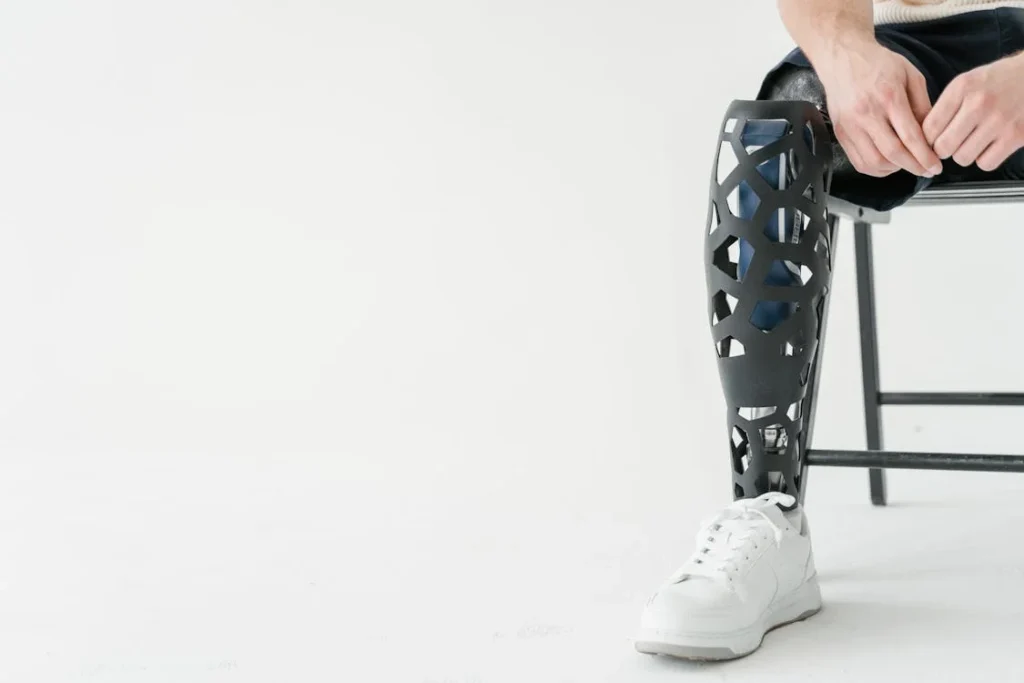Bionic and advanced prosthetics have transformed lives, offering unprecedented levels of mobility, functionality, and independence. These devices, crafted with cutting-edge technology, are not just tools—they are integral parts of the user’s everyday life. To ensure they continue to perform at their best, proper care is essential. When you take the time to maintain your prosthetic, you not only extend its lifespan but also enhance its comfort, reliability, and performance.
This guide will walk you through the best practices for caring for your bionic or advanced prosthetic, helping you keep it in top condition so you can focus on living your life without limits.
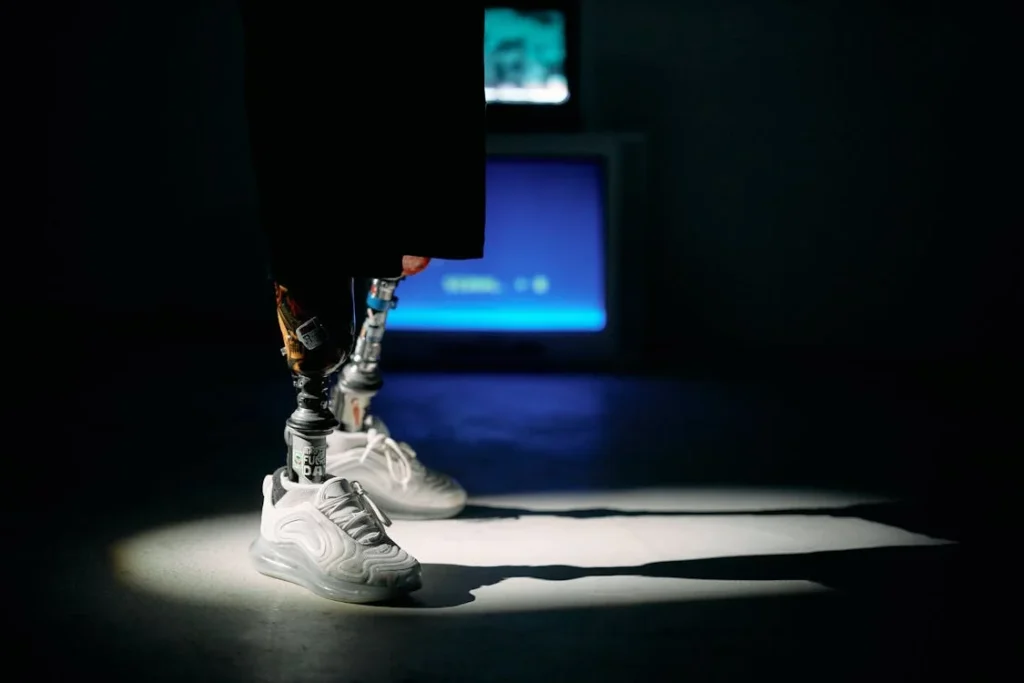
Understanding the Importance of Prosthetic Care
Prosthetic care is the foundation of a successful and comfortable experience for individuals who rely on these advanced devices.
While bionic and advanced prosthetics are built to be durable and functional, their performance and longevity are directly influenced by how well they are maintained.
This care goes beyond routine cleaning; it involves a proactive approach to preserving the intricate balance between the device, your body, and your daily activities.
How Care Enhances Performance
Every component of a prosthetic—be it the socket, liner, or advanced sensors—functions as part of a unified system. When one part isn’t properly maintained, the entire system’s performance can be compromised.
For example, an unclean liner may reduce the grip on your residual limb, creating discomfort or instability. Similarly, neglecting battery care in a bionic prosthetic could lead to erratic function or even device failure.
Proper care ensures that each element works seamlessly, supporting fluid and natural movements.
A well-maintained prosthetic not only performs better but also responds more intuitively to your needs. Advanced features like myoelectric controls or motion sensors are designed to detect even the subtlest of signals.
When cared for diligently, these systems operate with precision, making tasks feel effortless and natural.
Preventing Discomfort and Complications
Neglecting prosthetic care can lead to discomfort and, over time, more serious complications. Accumulated dirt or sweat can irritate the skin, causing redness, sores, or infections.
These issues are not only painful but can also disrupt your ability to wear the prosthetic for extended periods.
Misalignment or wear in mechanical components can alter the device’s interaction with your body, leading to uneven pressure distribution or restricted movement.
Left unaddressed, such issues may force you to overcompensate with other muscles and joints, potentially causing strain or injuries. Regular care helps you catch these problems early, minimizing risks to your physical well-being.
Supporting Emotional Confidence
A well-cared-for prosthetic doesn’t just support physical health; it also boosts emotional confidence. Knowing that your device is in top condition allows you to approach daily activities with ease, without worrying about unexpected failures or discomfort.
This sense of reliability fosters independence and helps you maintain a positive outlook.
Conversely, neglecting care can create stress and uncertainty, as minor issues can escalate into larger challenges. Consistent maintenance alleviates these concerns, ensuring that your prosthetic remains a dependable part of your life.
Adapting to Life’s Changes
Your prosthetic needs to adapt as your life evolves. Changes in your residual limb’s size, activity level, or lifestyle can all influence how your device performs. By prioritizing care, you ensure that your prosthetic keeps pace with these changes, maintaining its alignment and fit.
For instance, an individual who begins a more physically demanding routine may require adjustments to the socket or upgrades to the device’s components. Proactive care allows you to identify and implement these changes before they impact your mobility or comfort.
A Holistic Approach to Prosthetic Care
Caring for your prosthetic is not a single task but an ongoing process that involves your prosthetist, daily routines, and a commitment to understanding your device.
It’s about creating harmony between your prosthetic and your lifestyle, ensuring that the device enhances rather than hinders your quality of life.
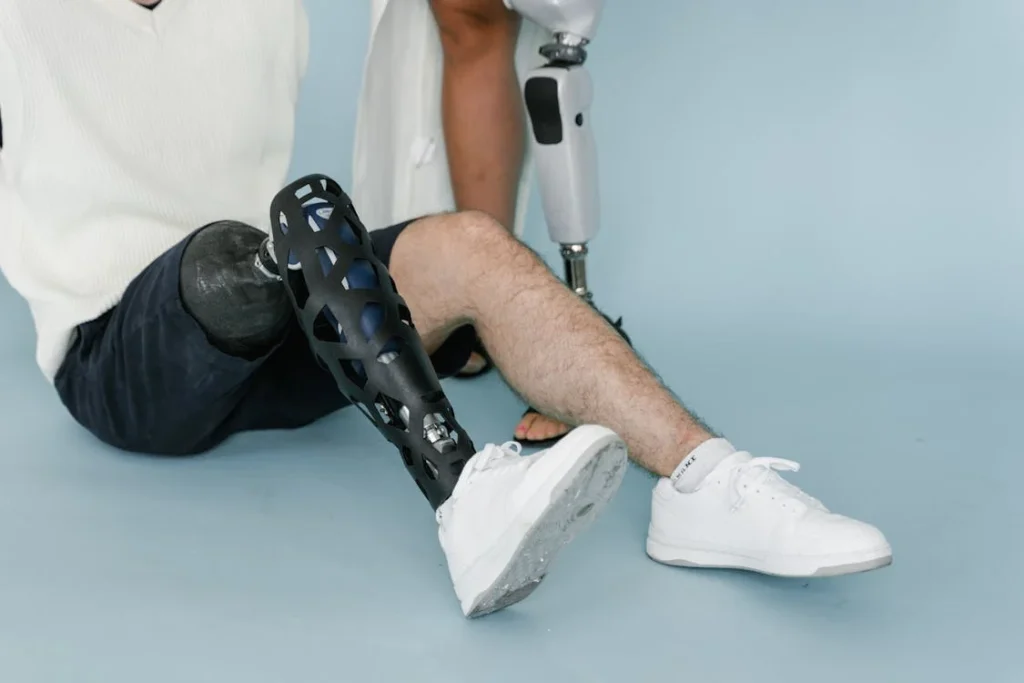
Daily Maintenance for Long-Term Success
Caring for your bionic or advanced prosthetic on a daily basis is the cornerstone of its longevity and reliability.
While these devices are built with durability in mind, the small efforts you put into their maintenance each day ensure they remain comfortable, functional, and responsive to your needs.
Daily care is not merely about avoiding problems—it’s about cultivating a routine that enhances your connection with the prosthetic and optimizes its performance over time.
Establishing a Daily Cleaning Ritual
Cleaning your prosthetic is more than just a matter of hygiene; it’s a preventative measure that protects both the device and your residual limb.
The buildup of dirt, sweat, and oils can affect the prosthetic’s materials, reducing their grip and causing premature wear. A consistent cleaning routine ensures that every part of your device functions as intended.
When cleaning, focus on areas that experience the most contact, such as the liner, socket, and straps. Use a gentle soap that doesn’t leave residue, and follow up with a thorough drying process.
Even minor traces of moisture can lead to corrosion in mechanical parts or discomfort for your skin. This simple daily act ensures your prosthetic feels fresh and functions effectively each time you wear it.
Monitoring Performance Through Routine Checks
Every prosthetic user’s routine is unique, and the daily wear on the device reflects those differences. By incorporating a quick inspection into your routine, you can identify signs of stress or strain that may not yet be noticeable during use.
Check for loose screws, uneven surfaces, or unusual sounds that could indicate mechanical wear. For bionic prosthetics, observe any changes in responsiveness, such as delayed movements or irregular sensor behavior.
These checks take only a few minutes but allow you to address potential issues early, minimizing disruptions to your mobility.
Prioritizing Skin Care as Part of Maintenance
The connection between your residual limb and the prosthetic is critical for both comfort and functionality. Incorporating skin care into your daily maintenance routine ensures that your limb remains healthy and that the prosthetic continues to fit securely.
Wash and dry your residual limb thoroughly at the start and end of each day, removing any debris or sweat that may have accumulated.
Using a skin-friendly moisturizer can help maintain elasticity, but avoid heavy or greasy products that might interfere with the liner’s adhesion. This simple yet strategic habit reduces the risk of irritation or sores, creating a smoother interaction between your body and the device.
Customizing Your Maintenance Routine
While general guidelines for prosthetic care exist, your maintenance routine should reflect your specific needs, lifestyle, and prosthetic type.
For instance, individuals with active lifestyles may need to clean their devices more frequently or pay extra attention to high-impact components. Similarly, users in humid climates may need to focus on moisture management to prevent liner slippage or bacterial growth.
Being attentive to your unique circumstances allows you to adapt your daily care practices effectively. This proactive approach ensures your prosthetic remains a reliable and comfortable extension of your body, regardless of the challenges posed by your environment or activities.
Strengthening the Connection with Your Prosthetist
Daily maintenance doesn’t exist in isolation—it’s part of a larger strategy that includes regular communication with your prosthetist.
By tracking your maintenance practices and noting any changes or recurring issues, you create a valuable log of information to share during professional checkups.
This collaborative effort strengthens your ability to address concerns promptly and ensures that your prosthetic care routine remains aligned with your evolving needs.
When combined with professional insights, your daily efforts contribute to a seamless and empowering prosthetic experience.
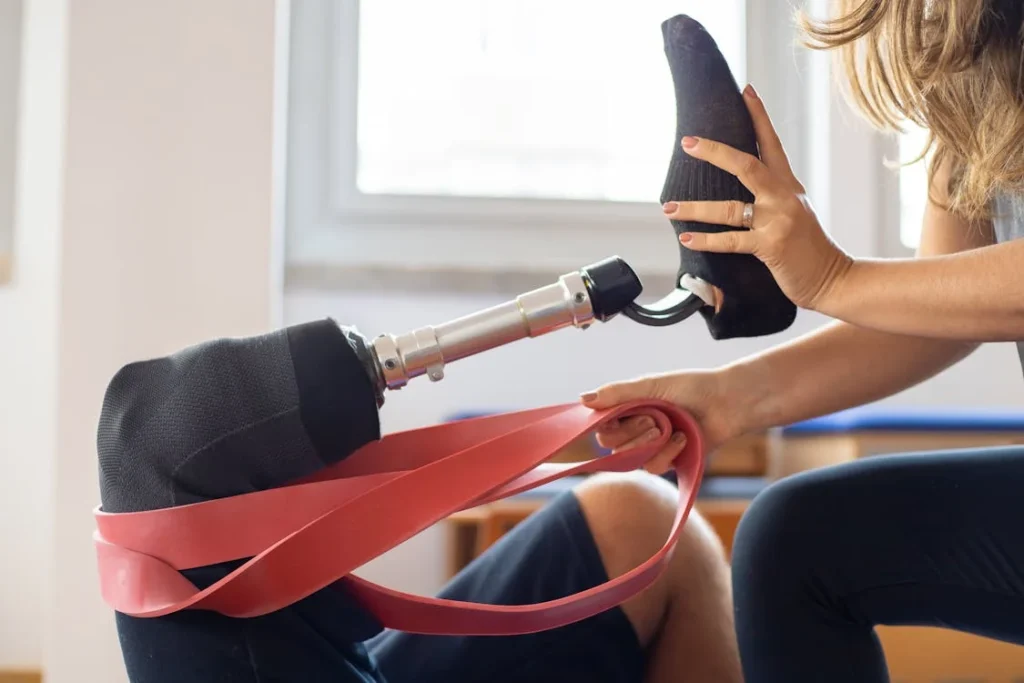
Maintaining the Connection with Your Residual Limb
The connection between your residual limb and your prosthetic is a delicate balance that directly impacts comfort, functionality, and overall satisfaction with your device.
This interface is where your body meets the technology, making it the foundation of a successful prosthetic experience.
Caring for this connection requires a thoughtful approach that addresses the needs of both your body and the prosthetic, ensuring they work together seamlessly.
Understanding the Importance of a Secure Fit
A secure fit is essential for stability and control, enabling your prosthetic to function as a natural extension of your body.
When the connection between your residual limb and the prosthetic socket is loose or inconsistent, it can lead to discomfort, instability, and even a lack of confidence in using the device.
Maintaining this fit requires more than periodic adjustments—it involves daily attention to how your limb interacts with the prosthetic. Swelling, changes in residual limb volume, and environmental factors such as humidity can all influence the fit.
Being aware of these changes allows you to respond quickly, whether by adjusting the socket, modifying your liner, or consulting your prosthetist.
Protecting Skin Health to Preserve the Connection
The skin on your residual limb acts as the first point of contact with your prosthetic, making its care a top priority. Irritation, blisters, or redness can disrupt the connection and make wearing the prosthetic uncomfortable or even painful.
Preventing these issues begins with a rigorous skin care routine tailored to your specific needs.
Cleaning your residual limb at least once daily removes sweat and debris that can accumulate under the liner, reducing the risk of irritation.
For those with sensitive skin, using hypoallergenic cleansers can provide added protection. Moisturizing the skin without overloading it with greasy products ensures it remains elastic and healthy while maintaining a secure grip with the prosthetic.
Adapting to Changes in Residual Limb Volume
The residual limb can change in size and shape due to various factors, including physical activity, temperature, and time of day. These fluctuations can affect the prosthetic’s fit, making it important to monitor and address changes proactively.
Adding or removing prosthetic socks is one way to manage minor changes in volume, ensuring the socket maintains its snugness. However, significant changes may require a professional adjustment to the socket itself.
Regularly measuring and observing your residual limb helps you anticipate these changes and maintain a consistent connection with your prosthetic.
Managing Sweat and Moisture
Excess moisture can compromise the fit and comfort of your prosthetic by causing the liner to slip or the skin to become irritated. This is especially common in humid climates or during high levels of physical activity.
Taking proactive steps to manage moisture ensures that your prosthetic remains secure and comfortable throughout the day.
Using moisture-wicking liners or applying a prosthetic-specific antiperspirant can help keep the area dry.
Additionally, removing the liner periodically to clean and dry both your limb and the prosthetic can prevent moisture-related issues from developing. These simple practices go a long way in maintaining the critical connection between your body and your device.
Regular Communication with Your Prosthetist
Your prosthetist plays a key role in ensuring the connection between your residual limb and prosthetic remains optimal. Open communication about how the prosthetic feels and any challenges you encounter allows for timely adjustments or upgrades.
For example, if you notice recurring pressure points or discomfort, your prosthetist can evaluate the socket design and make modifications to redistribute pressure more evenly.
This collaborative approach ensures that your prosthetic evolves alongside your body, maintaining a secure and comfortable fit over time.
Emotional Connection to the Fit
Maintaining the connection with your residual limb isn’t just about the physical aspects—it also involves an emotional relationship with the prosthetic. A comfortable fit fosters confidence, allowing you to trust the prosthetic as a reliable tool for mobility and independence.
Conversely, a poor fit can create frustration or hesitation, leading to reduced usage and missed opportunities for activity.
Addressing both the physical and emotional aspects of the connection strengthens your ability to engage fully with the prosthetic and embrace its role in your daily life.
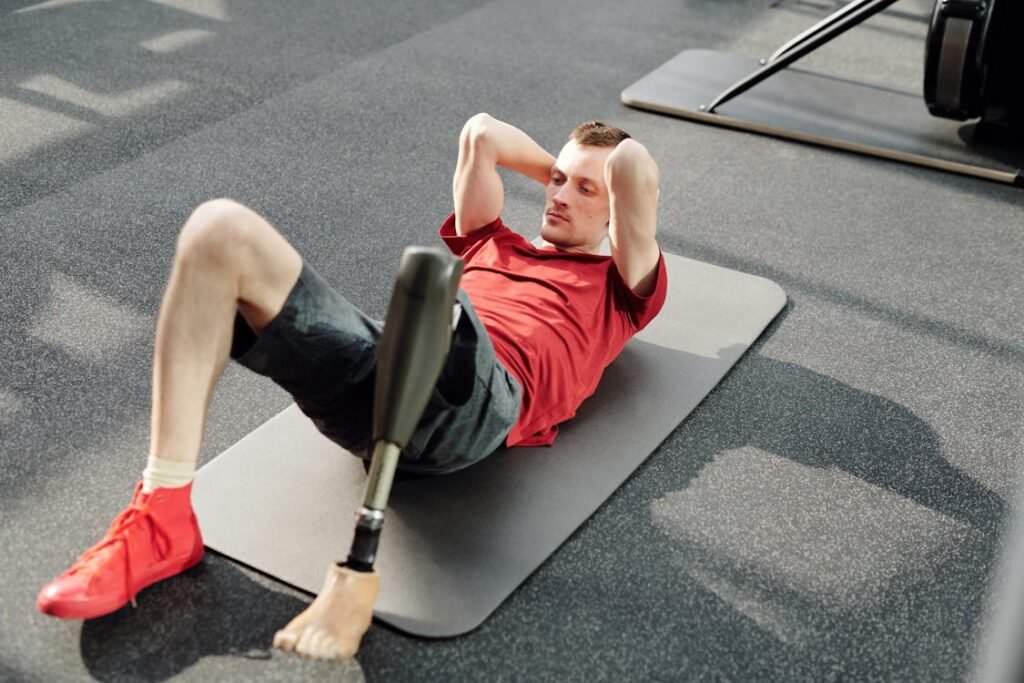
Extending the Lifespan of Advanced Components
Advanced prosthetics are intricate devices that combine mechanical precision with cutting-edge technology, such as microprocessors, sensors, and energy-efficient materials.
While these components are engineered for durability and performance, their longevity depends significantly on how they are cared for. A strategic approach to maintenance ensures that each part functions optimally, offering reliability and seamless integration into your daily life.
The Role of Preventive Care in Longevity
Preventive care is the cornerstone of extending the lifespan of advanced prosthetic components. Small issues, such as a loose connection or a poorly functioning sensor, can escalate if ignored.
Regular inspections of mechanical and electronic parts allow you to address these problems early, ensuring that minor adjustments prevent significant disruptions.
For example, monitoring how your prosthetic reacts during activities can reveal subtle signs of wear, such as slower responses from sensors or changes in grip strength.
Catching these indicators early minimizes the risk of a complete breakdown, protecting both the prosthetic and your peace of mind.
Protecting Electronic Components from Environmental Hazards
Advanced prosthetics often include electronics that enhance their functionality, such as myoelectric controls, gyroscopes, or Bluetooth connectivity.
These components, while durable, are sensitive to environmental hazards like moisture, dust, and extreme temperatures. Proper storage and handling are critical to shielding these systems from potential damage.
When not in use, store your prosthetic in a clean, dry place, ideally in a protective case or bag designed to minimize exposure to dust and humidity.
Avoid leaving it in areas with temperature extremes, such as a parked car on a hot day or a freezing garage in winter. These precautions maintain the integrity of electronic circuits and prevent malfunctions.
Maximizing Battery Life for Bionic Devices
Bionic prosthetics rely on batteries to power their advanced functions, and proper battery care is essential for consistent performance. Poor charging habits, such as overcharging or allowing the battery to deplete entirely, can shorten its lifespan.
To preserve battery health, follow the manufacturer’s guidelines for charging cycles and avoid leaving the prosthetic connected to the charger for extended periods.
It’s also beneficial to monitor battery performance, noting any reductions in capacity or runtime. If you notice a decline, consult your prosthetist for recommendations, which may include recalibration or replacement of the battery.
Maintaining Mechanical Precision
Mechanical components, such as joints, hinges, and sockets, play a critical role in the functionality of advanced prosthetics. Over time, these parts may experience wear from repeated use, particularly in high-stress areas like the knee or ankle of a lower-limb prosthetic.
To preserve their precision, regularly clean these components to remove dirt or debris that could interfere with movement. Lubrication may be necessary for certain joints, but it’s important to use products recommended by the manufacturer to avoid damaging materials.
Regular checkups with your prosthetist allow for a thorough evaluation of mechanical parts, ensuring that they remain aligned and functional.
Managing Software Updates
Many advanced prosthetics feature software that controls their operation, from fine-tuning grip sensitivity to enabling smoother walking patterns.
Keeping this software up to date is essential for maintaining peak performance. Updates often include bug fixes, enhanced features, or improved algorithms that adapt the prosthetic’s behavior to your unique needs.
Consult your prosthetist or the manufacturer for guidance on how to update the software safely. Regularly reviewing available updates ensures your device remains compatible with the latest advancements, extending its functionality and lifespan.
The Importance of Professional Maintenance
While daily care is vital, professional maintenance plays a key role in extending the lifespan of advanced components. Prosthetists have the expertise and tools to perform detailed inspections and repairs that go beyond what can be achieved at home.
During these appointments, your prosthetist can recalibrate sensors, test the alignment of mechanical parts, and assess the condition of electronic systems.
This comprehensive evaluation not only resolves existing issues but also identifies potential concerns, allowing for preemptive action that protects your prosthetic’s performance and durability.
Long-Term Benefits of Strategic Maintenance
Investing in the care of advanced components yields long-term benefits that go beyond the prosthetic itself.
A well-maintained device provides a consistent user experience, reducing the likelihood of unexpected failures that could disrupt your daily life. It also supports your confidence and independence, as you can trust your prosthetic to perform reliably in any situation.
Furthermore, extending the lifespan of your prosthetic through strategic maintenance reduces the need for costly repairs or replacements. This approach is not only financially prudent but also environmentally responsible, as it minimizes waste and resource consumption.
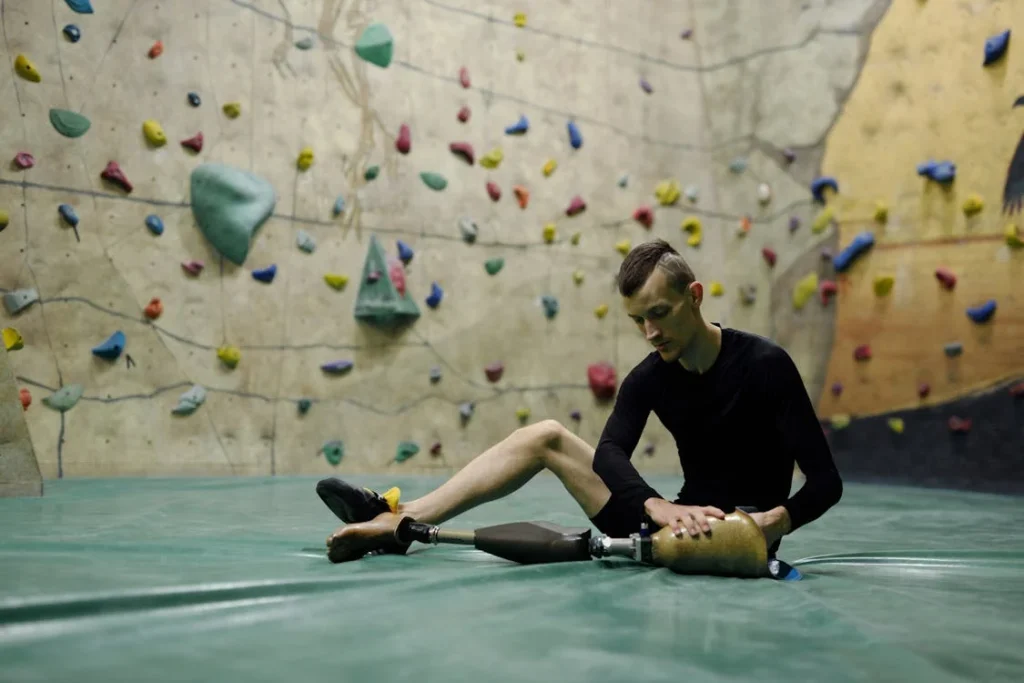
Routine Checkups and Professional Maintenance
Advanced prosthetics are sophisticated devices that integrate seamlessly into daily life, but maintaining their performance requires consistent professional attention.
While daily care can address immediate needs, routine checkups and professional maintenance offer a deeper level of care. These regular appointments not only ensure the continued functionality of your prosthetic but also help you adapt to changes in your body or lifestyle.
Strategic professional maintenance is essential for optimizing your prosthetic’s lifespan, functionality, and your overall experience.
The Strategic Value of Regular Evaluations
Routine checkups with your prosthetist serve as a proactive measure, helping to identify and resolve potential issues before they escalate into major problems.
Unlike daily maintenance, which focuses on cleaning and minor adjustments, professional evaluations delve into the intricate details of your prosthetic’s performance.
Your prosthetist will carefully examine every component of the device, from the fit of the socket to the calibration of advanced sensors and microprocessors.
These detailed inspections can reveal subtle signs of wear, alignment shifts, or software glitches that might not be immediately noticeable to you. By addressing these issues early, routine checkups prevent discomfort, performance declines, and unexpected failures.
Adapting to Changes in Your Residual Limb
Over time, your residual limb may change in size, shape, or sensitivity due to factors such as weight fluctuations, muscle tone variations, or natural physiological changes.
These shifts can impact the fit and comfort of your prosthetic, making regular professional adjustments essential.
During checkups, your prosthetist will assess how your prosthetic interacts with your residual limb and make necessary modifications to maintain a secure and comfortable fit.
This may include resizing the socket, replacing liners, or fine-tuning alignment to ensure even pressure distribution. These adjustments enhance not only your physical comfort but also your confidence in the prosthetic’s performance.
Optimizing Alignment and Gait
The alignment of your prosthetic is a critical factor in your overall mobility and comfort. Even minor misalignments can lead to uneven pressure, restricted movement, or strain on other parts of your body, such as your hips, knees, or lower back.
Over time, these issues can cause secondary problems, such as joint pain or muscular imbalances.
Routine checkups allow your prosthetist to assess and optimize the alignment of your prosthetic, ensuring it supports your natural gait and posture.
This fine-tuning not only prevents discomfort but also improves the efficiency of your movements, enabling you to perform daily activities with ease and confidence.
Ensuring the Reliability of Advanced Components
Advanced prosthetics often include electronic and mechanical systems that require specialized care. Routine professional maintenance ensures that these components remain in peak condition.
Your prosthetist will test sensors, calibrate microprocessors, and check the integrity of mechanical parts like hinges and joints.
For example, bionic prosthetics with myoelectric controls rely on precise electrical signals from your muscles to function effectively.
Over time, changes in muscle activity or wear on the sensors can affect performance. Regular recalibration during checkups ensures that the prosthetic continues to respond accurately to your movements.
Upgrading and Future-Proofing Your Prosthetic
Routine checkups also provide an opportunity to explore upgrades or enhancements to your prosthetic. As technology advances, newer components or features may become available that can improve your device’s performance, comfort, or durability.
For instance, an upgraded liner material might offer better moisture control, or a software update might introduce enhanced motion tracking.
Your prosthetist can advise you on these advancements and help you decide when it’s the right time to incorporate them into your prosthetic. This forward-thinking approach ensures your device remains compatible with the latest innovations, future-proofing it against obsolescence.
Building a Collaborative Relationship
Routine professional maintenance is not just about the prosthetic—it’s also about building a strong partnership with your prosthetist. Open communication about your experiences, challenges, and goals allows your prosthetist to tailor their care to your unique needs.
For example, if you’ve recently taken up a new hobby or increased your physical activity, sharing this information helps your prosthetist make adjustments to support your lifestyle.
This collaborative relationship ensures that your prosthetic evolves alongside you, providing continuous support for your ambitions and aspirations.
Long-Term Benefits of Regular Maintenance
The benefits of routine checkups extend far beyond the immediate improvements in your prosthetic’s functionality.
By investing in professional maintenance, you reduce the risk of costly repairs or replacements, enhance your device’s lifespan, and ensure it continues to meet your needs over time.
Additionally, regular care minimizes disruptions to your daily life, allowing you to rely on your prosthetic with confidence.

Adapting to Environmental Factors
Environmental conditions play a significant role in how your prosthetic performs and how comfortable it feels throughout the day.
Advanced prosthetics are designed to function in diverse settings, but adapting to specific environmental challenges ensures they continue to perform optimally.
By understanding and addressing these factors, you can enhance the longevity, reliability, and functionality of your device while safeguarding your comfort and mobility.
The Influence of Temperature on Prosthetic Functionality
Extreme temperatures can significantly impact prosthetic materials and components. In hot climates, the combination of high temperatures and physical activity often leads to increased perspiration.
This can affect the grip of the liner, cause slippage, and lead to skin irritation. Moisture management becomes essential in such conditions, with moisture-wicking liners and regular cleaning playing a pivotal role in maintaining a secure and comfortable fit.
On the other hand, cold weather can reduce the flexibility of some materials, making movement feel less natural. Additionally, electronic components, such as batteries in bionic prosthetics, can lose efficiency in low temperatures.
Protecting your prosthetic by keeping it warm during colder months ensures smoother performance and prevents potential damage caused by material contraction or electronic malfunction.
Managing Humidity and Moisture
Humidity poses a unique set of challenges for prosthetic users. High moisture levels in the air can exacerbate sweating, increasing the risk of skin irritation and bacterial growth under the liner. This is particularly true in regions with tropical climates or during the monsoon season.
To adapt, it’s essential to create a routine that prioritizes both skin and prosthetic care. Cleaning the liner and socket more frequently, drying your residual limb thoroughly, and using antimicrobial or breathable liners can help mitigate the effects of humidity.
Investing in a prosthetic cover that repels moisture can also protect sensitive components from humidity-related damage.
Addressing Exposure to Water
For individuals who live near water bodies or engage in activities like swimming, exposure to water is a common concern. Unless specifically designed to be waterproof, most prosthetics are not built to withstand prolonged contact with water.
Even brief exposure to rain or splashes can harm electronic components or lead to corrosion in mechanical parts.
If your prosthetic is not water-resistant, using a protective cover during activities where water exposure is likely is crucial.
For those who require water-friendly prosthetics, discussing options with your prosthetist ensures you have a device that supports both your lifestyle and your environmental needs.
Coping with Dust and Debris
Dusty environments, whether due to outdoor activities or specific work settings, can affect the functionality of advanced prosthetics. Dust particles can infiltrate joints and hinges, causing friction or wear over time.
For bionic prosthetics, dust may interfere with sensors or electronic components, leading to reduced responsiveness.
To adapt, ensure your prosthetic is cleaned thoroughly after exposure to dusty conditions. Using a soft brush or cloth to remove particles from crevices can prevent damage to mechanical parts.
For added protection, consider prosthetic accessories designed to shield vulnerable areas from debris.
Adjusting for Terrain and Activity Levels
Environmental factors also include the type of terrain and the physical demands of your activities.
Uneven or rough terrain, for example, places additional strain on lower-limb prosthetics, requiring the device to absorb more impact and provide greater stability.
In such cases, components like shock absorbers or specialized foot modules can make navigating these conditions easier.
For upper-limb prosthetics, activities that involve repetitive motions or high levels of force can affect the durability of components like grips or motors.
Understanding the demands of your environment and adapting your prosthetic accordingly ensures that it continues to perform effectively without compromising its integrity.
Creating a Routine for Environmental Adaptation
Adapting to environmental factors involves more than reactive measures—it requires a proactive routine tailored to your surroundings.
Regularly assessing the condition of your prosthetic after exposure to challenging environments, maintaining a cleaning schedule, and consulting with your prosthetist about necessary adjustments or upgrades can make a significant difference.
By incorporating these strategies into your care routine, you ensure that your prosthetic remains a dependable companion, capable of withstanding the demands of your environment.
Conclusion
Caring for bionic and advanced prosthetics is an ongoing commitment that goes beyond routine cleaning and maintenance. It’s about fostering a seamless connection between your body and your device, ensuring reliability, comfort, and optimal performance in every step of your journey. From daily upkeep to professional checkups, thoughtful care enhances the longevity of your prosthetic and supports your quality of life.
At Robobionics, we’re here to support you at every stage, offering innovative prosthetic solutions, expert guidance, and personalized care plans. Whether you’re new to advanced prosthetics or looking to optimize your existing device, our goal is to help you achieve a seamless and empowering experience.
Ready to elevate your prosthetic care? Contact Robobionics today to learn more about advanced prosthetic solutions and expert maintenance services.



